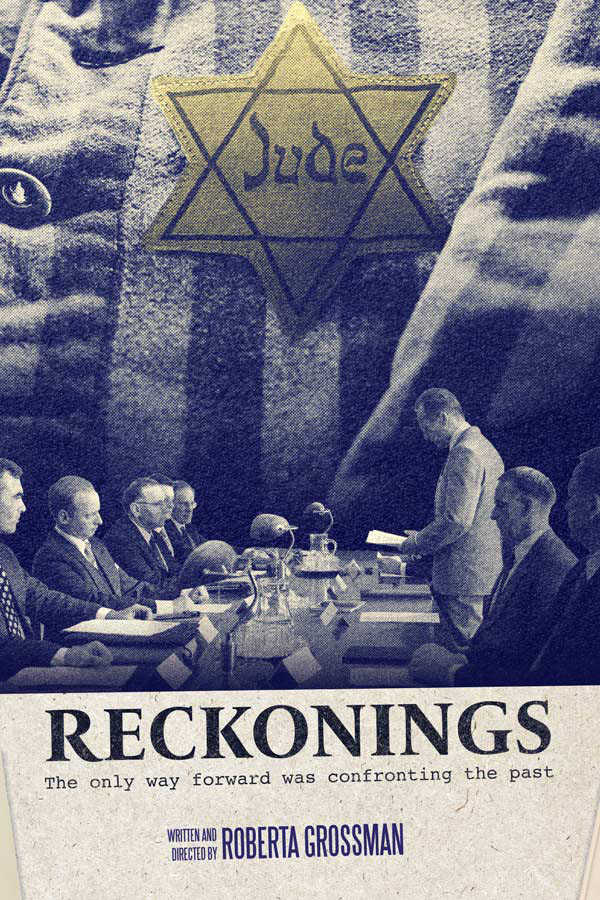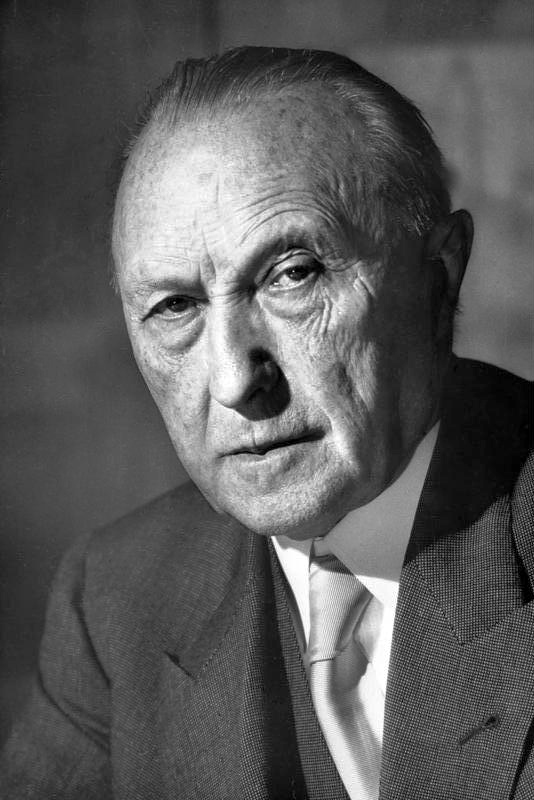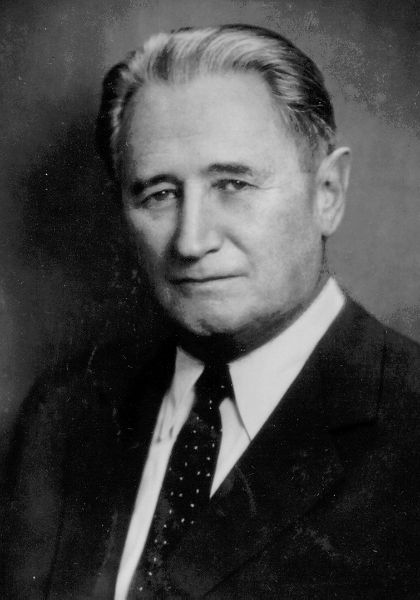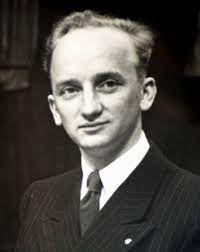Features
“Reckonings” – riveting documentary film explains how the agreement to offer reparations to Holocaust victims came about

By BERNIE BELLAN Since 1952 the German government has paid more than $562 billion in compensation for crimes committed during the Holocaust, of which $472 billion has been paid to the State of Israel (in goods and services) and $90 billion in cash to individual Holocaust survivors.
How the German government came to agree to compensate victims of the Holocaust is a fascinating story – and one that is the subject of a spellbinding documentary film called “Reckonings.”
On Sunday afternoon, November 12 over 150 people gathered in the auditorium of Westwood Collegiate in St. James to view “Reckonings” and to participate in a discussion that followed the film led by Jewish Heritage of Western Canada Executive Director Belle Jarniewski and Jewish Child and Family Service Holocaust Support Services Worker Adeena Lungen.
The event was timed to coincide with the 85th anniversary of Kristallnacht – “the night of broken glass,” which took place Nov. 9-10, throughout Germany, when over 7,000 Jewish businesses were damaged or destroyed, 30,000 Jewish men were arrested and incarcerated in concentration camps, and at least 100 Jews killed.
“Reckonings,” released in 2022, was directed by award-winning documentary filmmaker Roberta Grossman. In a style first pioneered by documentary filmmaker Ken Burns, Grossman uses historical footage, occasional reenactments, interviews with various individuals who appear from time to time throughout the film – but never for more than a couple of minutes at one time, and music composed to fit the moment, all in a fast-cutting mode that maintains your attention throughout the 74 minutes of the film.

The crux of the story is how the West German government, led by Chancellor Konrad Adenauer, decided to take full responsibility for the crimes of the Holocaust, and offer reparations to Holocaust victims.
If there is any one hero in this film, it is Adenauer. As the film explains, he was a former mayor of Cologne whose family was fiercely anti-Nazi. As well, Adenauer was a devout Catholic – something that played a significant role in his wanting to come to terms with German guilt and atone for the collective sins of the German people.

On the Jewish side, the key figure working with Adenauer – and negotiating on behalf of Holocaust victims was Nahum Goldmann, who co-founded the World Jewish Congress in 1936 with Rabbi Stephen Wise.
Goldmann had been stripped of his German citizenship by the racist German Nuremberg laws (and although the film doesn’t explain it, he found refuge in Honduras.) Yet, the fact he was German-born and was able to develop a warm relationship with Adenauer proved key to the eventual creation of what came to be known as the “The Conference on Jewish Material Claims Against Germany.”
The film unravels the many complexities that were involved in negotiating what turned out to be an agreement of monumental consequence, especially bringing together Jewish and German negotiators across from one another.
In the opening moments of “Reckonings,” co-producer Karen Heilig observes, “You can just imagine what it was like for Jewish representatives to sit down with German representatives only seven years after World War II…It was like negotiating with the devil.”
As the film explains, Israelis themselves were largely opposed to negotiating reparations with the German government. As Heilig observes, “They didn’t want German money.”
Similarly, most of the German population was also opposed to the idea of reparations. “Only 11% of the German population supported compensation” for Jews, according to the film.
In a very interesting insight into the psyche of the German population following the war, it is also noted that, when it came to who the German people thought were most victimized by the war, “Jews were last on the list.”
Amidst what was evidently still a deeply-rooted antisemitism within the German population – and strong opposition from within his own party (Christian Democrat), Adenauer remained adamant that Germany would negotiate reparations – both for individual victims of the Holocaust and for the recently formed State of Israel. (The Federal Republic of Germany itself only came into being in 1949.)
One of the crucial factors in Israel agreeing to negotiate reparations – after having been so solidly opposed, came toward the end of 1951, the film explains, as a result of the Israeli treasury almost being totally bare. The reason was the extraordinarily high cost that the Israeli government had incurred as a result of absorbing hundreds of thousands of refugees since the formation of the state – both Holocaust survivors and refugees from Arab countries.
Yet, despite the precarious state of Israel’s finances, there were still many who refused to countenance the notion of Israel accepting German reparations. In fact, at the time that negotiation began, in 1952, there was a boycott of German goods in Israel.
As the leader of Herut (also leader of the Opposition in the Knesset), Menachem Begin insisted, “reparations will lead to cleansing the guilt of the German people.”
However, notwithstanding the fierce opposition from among many Israelis to entering into negotiations with the German government, Israel’s government, led by David Ben Gurion, did announce that it was ready to discuss reparations, but it led off with a claim for $1 billion – the cost, it said, for absorbing 500,000 Holocaust survivors.
Adenauer agreed to negotiate with both the Israeli government and a representative organization of the Jewish people – but at the time there was no organization in place to do that.
Thus was created “The Conference on Jewish Material Claims Against Germany,” with Nachum Goldmann at its head. The other members of the negotiating team had clear goals in mind: What they were negotiating with the West German government was not about “morality,” it was about dollars and cents.
To that end, the negotiators wanted to break down compensation into two different categories: compensation for personal suffering and compensation for property lost to the Nazis.
The problem was: Who would claim compensation for property when everyone who might have owned particular properties had been annihilated?
I actually put that question to Adeena Lungen during the discussion that followed, since the film didn’t go into any detail as to how that circle could be squared. Adeena explained that survivors of Holocaust victims are often able to claim compensation for personal suffering, for which there is significant information available, but compensation for loss of property is often much more difficult to ascertain.
Agencies such as JCFS, which help survivors apply for compensation often rely upon archival information that “gives a wealth of information about property based on the recollections of others from a particular shtetl.” As Adeena further noted, “in Poland, wherever you lived there was a document that recorded where you lived” – and there is now an “online database” based upon those documents from where anyone can get detailed information about where individuals lived.
Before teams representing the three parties (West Germany, Israel, and the Conference on Jewish Material Claims Against Germany) for the coming negotiations met, however, Konrad Adenauer met with Nahum Goldmann in secret to determine certain basic points: Was West Germany actually ready to pay reparations and where would the negotiations take place?
The answers to those questions were: Yes, West Germany was ready to pay and two, the negotiations were to be held in a neutral county – in this case, The Netherlands.
Although Israel and the Claims Conference were to be separate parties to negotiations with West Germany, it was agreed that Israel and the Claims Conference would coordinate their strategies together.
Prior to the commencement of negotiations, however, the film explains, “German officials wanted to come to terms with the rest of the world, then Israel and the Claims Conference,” but Israel took the position that “No, you have to come to terms with us and the Claims Conference, then the rest of the world.”
With West Germany accepting that as a pre-condition to negotiations, the representatives met and, after a prolonged series of negotiations, West Germany did agree to provide $857 million in reparations, of which $750 million was to go to Israel (but not in cash, as the film explains; rather, it was in goods and services, including raw materials, industrial machinery, and ships for the Israeli navy), while the Claims Conference was to receive $107 million.
However, many individuals were excluded from the deal to receive compensation, including anyone living behind the Iron Curtain and people who had been in hiding during the war.
One of the key individuals during the negotiations with Germany was Ben Ferencz, who passed away this past April. Not only was Ferencz the sole surviving negotiator for the Claim Conference, as Belle Jarniewski also pointed out, Ferencz was the last surviving prosecutor from the famed Nuremberg trials of Nazi war criminals. Ferencz is featured quite prominently in “Reckonings,” as he was able to give a first-hand account of what the negotiations were like.
The final agreement worked out between West Germany and Israel, on the one hand, and West Germany and the Claims Conference, on the other, came to be known as the Luxembourg Agreement. It has served as the basis for all subsequent agreements to compensate Holocaust victims by the German government.

Of the $90 billion that has been paid out in reparations since 1953, over 270,000 Holocaust survivors were among the first recipients of the initial $107 million paid in 1953. Since then, an additional 500,000 individuals have received payments. And, although the Luxembourg agreement was only intended to provide compensation to survivors in 1953, ever since then there have been regular negotiations between the German government and the Claims Conference, which have resulted in varying amounts being negotiated each time.
Insofar as Holocaust survivors who moved to Winnipeg are concerned – of whom there have been over 1500 individuals over the years, Belle Jarniewski explained the process through which they receive compensation from the German government.
In 1948 something called the United Restitution Office was established to help Holocaust survivors. (The Canadian office was founded in 1952.) The purpose of the office was to help survivors with individual claims. Case files were established for survivors, including claims and documentation describing difficulties survivors have encountered during their lifetimes. In 2022 those files were transferred to the care of the Jewish Heritage Centre.
Adeena Lungen (about whose role at JCFS helping Holocaust survivors we described in some detail in an article in our December 20, 2021 issue, which can be downloaded on our website – simply go to jewishpostandnews.ca and, under the “Search Archive” tab at the top, and enter Dec. 20, 2021 to download the complete issue. The article about Adeena is on page 3.), explained that JCFS has been working with Holocaust survivors in Winnipeg since 2000. Adeena has been serving in her role as Holocaust support services worker for the past 20 years, she noted.
Adeena noted that, in addition to compensation available from the German government for Holocaust survivors, other countries have, in recent years, also begun to offer compensation in certain cases. (For instance, in our two most recent issues we posted an advertisement for compensation now being offered to Jews who were former residents of Lithuania.) Other countries offering compensation now include France, Austria, Poland and Romania, Adeena added.
When asked how a survivor could go about proving that they are actually a Holocaust survivor (and there have been numerous bogus attempts over the years by individuals falsely claiming to be Holocaust survivors), Adeena described the steps JCFS, for instance, will take to verify someone’s claim, noting however that, while JCFS will do an initial assessment of someone’s claim, the final determination rests with the Claims Conference.
According to Adeena, a claimant must submit documents, such as identity papers from the country of origin.
Currently there are still 200,000 Holocaust survivors worldwide, of whom 150,000 have been receiving distributions from the Claims Conference. Adeena noted that new files are still being opened for Holocaust survivors. (Apparently there are still Holocaust survivors who have been unaware that they are eligible to receive compensation.)
In 2022, for instance, the Claims Conference was able to distribute $562 million to 150,000 individual Holocaust survivors. An additional $750 million was distributed to social welfare agencies worldwide, including JCFS. If you would like more information about compensation for Holocaust survivors, contact Adeena Lungen at alungen@jcfswinnipeg.org.


Features
Rob Reiner asked the big questions. His death leaves us searching for answers.

Can men and women just be friends? Can you be in the revenge business too long? Why don’t you just make 10 louder and have that be the top number on your amp?
All are questions Rob Reiner sought to answer. In the wake of his and his wife’s unexpected deaths, which are being investigated as homicides, it’s hard not to reel with questions of our own: How could someone so beloved come to such a senseless end? How can we account for such a staggering loss to the culture when it came so prematurely? How can we juggle that grief and our horror over the violent murder of Jews at an Australian beach, gathered to celebrate the first night of Hanukkah, and still light candles of our own?
The act of asking may be a way forward, just as Rob Reiner first emerged from sitcom stardom by making inquiries.
In This is Spinal Tap, his first feature, he played the role of Marty DiBergi, the in-universe director of the documentary about the misbegotten 1982 U.S. concert tour of the eponymous metal band. He was, in a sense, culminating the work of his father, Carl Reiner, who launched a classic comedy record as the interviewer of Mel Brooks’ 2,000 Year Old Man. DiBergi as played by Reiner was a reverential interlocutor — one might say a fanboy — but he did take time to query Nigel Tufnell as to why his amp went to 11. And, quoting a bad review, he asked “What day did the Lord create Spinal Tap, and couldn’t he have rested on that day too?”
But Reiner had larger questions to mull over. And in this capacity — not just his iconic scene at Katz’s Deli in When Harry Met Sally or the goblin Yiddishkeit of Miracle Max in The Princess Bride — he was a fundamentally Jewish director.
Stand By Me is a poignant meditation on death through the eyes of childhood — it asks what we remember and how those early experiences shape us. The Princess Bride is a storybook consideration of love — it wonders at the price of seeking or avenging it at all costs. A Few Good Men is a trenchant, cynical-for-Aaron Sorkin, inquest of abuse in the military — how can it happen in an atmosphere of discipline.
In his public life, Reiner was an activist. He asked how he could end cigarette smoking. He asked why gay couples couldn’t marry like straight ones. He asked what Russia may have had on President Trump. This fall, with the FCC’s crackdown on Jimmy Kimmel, he asked if he would soon be censored. He led with the Jewish question of how the world might be repaired.
Guttingly, in perhaps his most personal project, 2015’s Being Charlie, co-written by his son Nick he wondered how a parent can help a child struggling with addiction. (Nick was questioned by the LAPD concerning his parents’ deaths and was placed under arrest.)
Related
None of the questions had pat answers. Taken together, there’s scarcely a part of life that Reiner’s filmography overlooked, including the best way to end it, in 2007’s The Bucket List.
Judging by the longevity of his parents, both of whom lived into their 90s, it’s entirely possible Reiner had much more to ask of the world. That we won’t get to see another film by him, or spot him on the news weighing in on the latest democratic aberration, is hard to swallow.
Yet there is some small comfort in the note Reiner went out on. In October, he unveiled Spinal Tap II: The Beginning of the End, a valedictory moment in a long and celebrated career.
Reiner once again returned to the role of DiBergi. I saw a special prescreening with a live Q&A after the film. It was the day Charlie Kirk was assassinated. I half-expected Reiner to break character and address political violence — his previous film, God & Country, was a documentary on Christian Nationalism.
But Reiner never showed up — only Marty DiBergi, sitting with Nigel Tuffnell (Christopher Guest), David St. Hubbins (Michael McKean) and Derek Smalls (Harry Shearer) at Grauman’s Chinese Theater in Los Angeles. The interview was broadcast to theaters across the country, with viewer-submitted questions like “What, in fact, did the glove from Smell the Glove smell like?” (Minty.) And “Who was the inspiration for ‘Big Bottom?’” (Della Reese.)
Related
- Actor-Director Rob Reiner dies at 78
- Carl Reiner On Judaism, Atheism And The ‘Monster’ In The White House
- Mandy Patinkin On His Favorite ‘Princess Bride’ Quote
DiBergi had one question for the audience: “How did you feel about the film?”
The applause was rapturous, but DiBergi still couldn’t get over Nigel Tuffnell’s Marshall amp, which now stretched beyond 11 and into infinity.
“How can that be?” he asked. “How can you go to infinity? How loud is that?”
There’s no limit, Tuffnell assured him. “Why should there be a limit?”
Reiner, an artist of boundless curiosity and humanity, was limitless. His remit was to reason why. He’ll be impossible to replace, but in asking difficult questions, we can honor him.
The post Rob Reiner asked the big questions. His death leaves us searching for answers. appeared first on The Forward.
Features
A People and a Pulse: Jewish Voices in Jazz and Modern Music

By MARTIN ZEILIG Jazz history is usually told through its most iconic names — Armstrong, Ellington, Parker, Davis — yet running alongside that familiar story is another, often under‑acknowledged one: the deep and enduring contribution of Jewish musicians, bandleaders, composers, and cultural intermediaries.
From the moment jazz emerged at the turn of the 20th century, Jews were not simply observers but active shapers of the music and the industry around it. Their influence — artistic, entrepreneurial, and cultural — has been both significant and, in many respects, disproportionately large. Jews and Jazz (171 pg. $18.75 US) a self‑published work by Laurence Seeff, brings this parallel narrative into sharp, affectionate focus.
Seeff is an ideal guide.
Born in London in 1951, he built a career that moved from statistics to energy policy in Paris, from financial markets at Bloomberg to corporate training in the City of London, all while writing poetry, songs, and humorous verse. Today he lives in Israel, where he continues to write, perform, learn Ivrit, and enjoy life with his large family. Through all these chapters runs a constant passion for jazz — a passion sparked more than fifty‑five years ago when he first heard Terry Lightfoot’s Jazzmen in a Bournemouth pub.
His writing blends clarity, humour, and genuine love for the music and the people who made it.
The musicians he profiles often came from immigrant families who brought with them the musical DNA of Eastern Europe — the cadences of synagogue chant, the urgency of klezmer, the cultural instinct for learning and artistic expression. When these sensibilities met the African American genius of early jazz, the result was a remarkable creative fusion.
Some figures, like Chico Marx, are better known for comedy than musicianship, yet Seeff reminds us that Chico was a serious pianist whose jazz‑inflected playing appeared in every Marx Brothers film and whose orchestra launched young talents like Mel Tormé. Others — Abe Lyman, Lew Stone, and Oscar Rabin — shaped the dance‑band era on both sides of the Atlantic.
Canadian readers will be pleased to find Morris “Moe” Koffman included as well: the Toronto‑born flautist and saxophonist whose “Swinging Shepherd Blues” became an international hit and whose long career at the CBC helped define Canadian jazz.
Seeff also highlights artists whose connection to jazz is more tangential but culturally revealing. Barbra Streisand, for example — a classmate and choir‑mate of Neil Diamond at Erasmus Hall High School — was never a natural jazz singer, yet her versatility allowed her to step into the idiom when she chose.
She opened for Miles Davis at the Village Vanguard in 1961 and, nearly half a century later, returned to the same club to promote Love Is the Answer, her collaboration with jazz pianist Diana Krall. Her contribution to jazz may be limited, but her stature as one of the greatest singers of all time is unquestioned.
Neil Diamond, too, appears in these pages.
Though not a jazz artist, he starred — with gusto, if not great acting finesse — in the 1980 remake of The Jazz Singer, 53 years after Al Jolson’s original. The film was not a success, nor was it truly a jazz picture, but its title and its star’s Jewish identity make it part of the cultural tapestry Seeff explores.
Diamond and Streisand recorded together only once, in 1978, on “You Don’t Bring Me Flowers,” a reminder of the long‑standing artistic ties between them.
Mel Tormé, by contrast, was deeply rooted in jazz. Nicknamed “The Velvet Fog,” he was a prodigy who sang professionally at age four, wrote his first hit at sixteen, drummed for Chico Marx, and recorded with Benny Goodman and Artie Shaw. Ethel Waters once said he was “the only white man who sings with the soul of a black man.” His story exemplifies the porous, collaborative nature of jazz.
Seeff also includes non‑Jewish figures whose lives intersected meaningfully with Jewish culture. Frank Sinatra — perhaps the greatest crooner of them all — was a steadfast supporter of Jewish causes, from protesting during the Holocaust to raising funds for Israel Bonds and the Hebrew University. His multiple visits to Israel, including a major concert in Jerusalem in 1975, underscore the depth of his connection.
Danny Kaye earns his place through his close work with Louis Armstrong, his pitch‑perfect scat singing, and his starring role in The Five Pennies, the biopic of jazz cornetist Red Nichols. Though not a jazz musician per se, his performances radiated a genuine feel for the music.
A later generation is represented by Harry Connick Jr., whose Jewish mother and New Orleans upbringing placed him at the crossroads of cultures. A prodigy who played publicly at age five, he went on to become one of the most successful jazz‑influenced vocalists of his era, with ten number‑one jazz albums.
Even Bob Dylan appears in Seeff’s mosaic — another reminder that Jewish creativity has touched every corner of modern music, sometimes directly through jazz, sometimes through the broader cultural currents that surround it.
Taken together, the concise portraits in Jews and Jazz form a lively, engaging mosaic — a celebration of creativity, resilience, and cross‑cultural exchange. They show how Jewish musicians helped carry jazz from vaudeville and dance halls into swing, bebop, cool jazz, pop, rock, and film music.
They remind us that jazz, at its heart, is a meeting place: a space where people of different backgrounds listen to one another, learn from one another, and create something larger than themselves.
For further information, contact the author at the following email address: laurenceseeff@yahoo.co.uk
Features
Jews in Strange Places

By DAVID TOPPER The Jewish contribution to 20th century popular music is well known. From Jerome Kern through to Stephen Sondheim, Jews played major roles as both composers and lyricists in the so-called Great American Songbook. (An exception is Cole Porter.) It continued in Musical Theatre throughout the rest of the century.
One very small piece of this story involves what Time magazine in the December 1999 issue called “the tune of the century.” First recorded sixty years before that, it is the powerful and haunting tune called “Strange Fruit,” which is about the lynching of black people in the southern USA. First sung by Billie Holiday in 1939, it became her signature tune.
So, why do I bring this up? Because there is a multi-layered Jewish connection to this song that is worth recalling, which may not be known to many readers.
Let’s start with the lyrics to “Strange Fruit,” which are the essence of this powerful piece:
Southern trees bear strange fruit,Blood on the leaves and blood at the root,Black bodies swinging in the southern breeze,Strange fruit hanging from the poplar trees.Pastoral scene of the gallant south,The bulging eyes and the twisted mouth,Scent of magnolias, sweet and fresh,Then the sudden smell of burning flesh.Here is fruit for the crows to pluck,For the rain to gather, for the wind to suck,For the sun to rot, for the trees to drop,Here is a strange and bitter crop.
Before becoming lyrics in a song, this poem stood alone as a potent statement about the lynchings still taking place throughout the American South at the time. The strong metaphorical imagery never explicitly mentions the lynching, which adds to the poetic power of this poem. Standing alone, I believe it’s an important protest verse from the 20th century.
Searching it on the internet, you may find the author listed as Lewis Allan. But that’s not his real name. “Lewis Allen” is the often-used pen name of Abel Meeropol, a Jewish High School teacher from the Bronx in New York. He and his wife, Anne (nee Shaffer), had two stillborn children with those names – a fact that adds a poignant element to this story.
The origin of the poem for Abel was a photograph he had seen of a lynching of black men in the South. I have seen such images, possibly even the one Abel saw: for example, a sepia photograph of two black men hanging from a long tree limb, and a large crowd of white people below (men, women and even children!), most seeming dressed in their Sunday best (some men with straw hats) looking up and gawking at the sight, some with smiles on their faces – as if attending a festive spectacle. Like Abel, I felt repelled by the picture: it turned my stomach. This communal display of horrific cruelty gave me a glimpse into Abel’s mind, and I understood how it compelled him to write about it. He thus wrote the poem, and it was published in a teacher’s magazine in 1937.
Being a songwriter too, in 1938 Abel added a melody and played it in a New York club he often attended. But here’s where this story’s documentation gets contradictory, depending upon who is recalling the events. The club owner knew Billie Holiday, and he showed the song to her. What her initial response was, we cannot know for sure. But we do know that in a relatively short time, she added it to her repertoire. It eventually became her signature tune. She initially sang it in public, but because of its popularity among her fans, there was pressure to record it too.
There were initial rejections from recording companies because of the controversial content. But Commodore Records took a chance and pressed the first recording in April 1939. This was the same year the movie “Gone with the Wind” came out; it was steeped in racial stereotyping. It was also sixteen years before Rosa Parks refused to give up her seat on a bus in Montgomery, Alabama.
As a record, the song obviously reached a large audience. Since the content was about racism, the song was seen as politically radical; not surprisingly, many radio stations banned it from the airwaves.
Furthermore, it’s also not surprising that Abel, a schoolteacher, was called to appear before a committee of New York lawmakers who were looking for communists in the schools. Possibly they were surprised to find that the poem and the song were written by a white man – and a Jew to boot. In particular, they wanted to know if he was paid by the Communist Party to write this song. He was not. And, in the end, they let him go. But shortly thereafter he quit his teaching job.
This took place in 1941 and was a precursor to the continued American obsession with communism into the 1950s, under Senator Joe McCarthy.
Indeed, that episode had an impact on Abel and Anne too. In 1953 Julius and Ethel Rosenberg were convicted of giving information about nuclear science to the Soviet Union, and they were the first married couple to be executed in the electric chair. They left two sons, Michael (age 10) and Robert (age 6). Apparently, immediate family members were reticent to get involved with the boys, possibly afraid of being accused of sympathizing with communism.
Enter Abel and Anne. Without a moment’s hesitation they stepped in, taking and raising the boys. As Michael and Robert Meeropol they eventually went on to become college professors – and naturally were active in social issues. Anne died in 1973. Abel died in 1986 in a Jewish nursing home in Massachusetts, after a slow decline into dementia. Long before that, Billie Holiday died in 1959, ravaged by the drug addition that took her life at forty-four years of age.
See why I called this a multi-layered Jewish story that’s worth telling?
To hear Billie Holiday singing “Strange Fruit” click here: Strange Fruit

